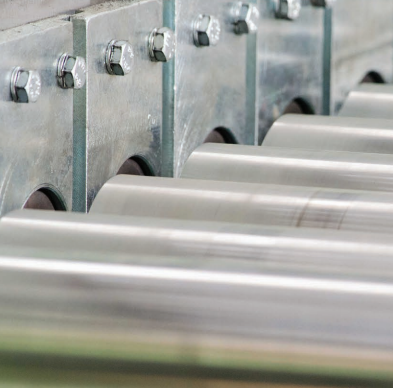

Rolls
Rolls play a significant role in the process of material classification in a roller screen/feeder.

Classification, Pellet Sizing & Concentrate Scalping
Roller screen is an equipment used for material sizing and separation. In the steel industry, roller screens are usually used for sizing two types of materials: iron ore concentrate, and iron ore heated pellets.
Base material vs. Coating
Rolls play a significant role in the process of material classification in a roller screen/feeder. The better the roll plays its role, the screen will perform better. Rolls are reviewed from two perspectives: base material, and coating.
FMS provides various base materials and different methods to coat the rolls.
The rolls are continuously undergoing remodeling to meet all the ever-increasing requirement of our customers.

Roll general characteristics
Less than 0.2 mm eccentricity
Up to 5 m length
Up to 250 um thickness of coating
Up to 67 HRC
Several types of coating materials such as chrome based materials, nickel based materials, and polymer base materials etc. are used to increase the life of each rolls.
Most common base materials & coatings are categorized as follow
Chrome plated coating
Stainless steel 304 and CA6NM
AF series coating
SF series coating
Stainless steel uncoated rolls have acceptable performance in pellet screening while long time working deforms outer diameter along roll that affects screening efficiency. Chrome plated rolls have higher life time comparing uncoated rolls and usually suggested for impact rolls. All roll coating creates the chance of recycling roll base material and recoating.

Stainless steel 304 and CA6NM
Both of the Stainless Steel 304 and CA6NM are widely used in roll production. Iron ore concentrate and pellets which are classified by the roller screens are wet and sticky. Stainless steel roll, as the name depicts, does not corrode when exposed to moisture. Also, due to the abrasive nature of the concentrate and pellets, rolls with material which is not moisture resistant or paint coated cannot be used. Therefore, stainless steel is the best choice for dealing with these materials.CA6NM on the other hand, is used where high wear resistance and yield strength are required. SS.304 is used where non.magnetic or low cohesion properties are required.
AF190
FMS is among very few companies in the world which specially manufacture wear resistant rolls called AF190. FMS roll production plant manufactures various types of AF series roll based on roll length and feed material specification. AF190 rolls are highly wear resistant due to the special characteristics of the coating material and coating procedure. Also, due to the surface friction special feature, the roll is exclusively suitable for pellet sizing roller screens.
AF190 Roll key advantages
Eliminates the regapping of rollers due to its wear
Reduces maintenance cost
Ensures a long working life
Increases production efficiency due to roll gap consistency
No regapping cycles
Improves pellet diameter uniformity

SF80
While performance of vibratory screens dramatically drops with increase in humidity and even un.functional for above 8% material humidity, FMS scalper screen has successfully utilized over years for scalping iron ore concentrate with 9-13% and capacity to 1000 tph. The innovative SF coating prevents sticking high humidity material to the rolls.

SF80 rolls are designed for scalper roller screens to collect junk and waste materials and protect HPGR (High Pressure Grinding Rolls). SF80 rolls are coated with a special polymer layer. Due to its high wear resistance, it prevents damage to the rolls due to the impact of hard objects and waste materials in the concentrate. Because of very low water absorption, it prevents sticking of wet concentrate that is continuously in contact with the rolls. Moreover low friction coefficient reduces the cohesive strength between the material and the roll surface, and as a result, the concentrate flows smoothly on the rolls and enters the product section.
